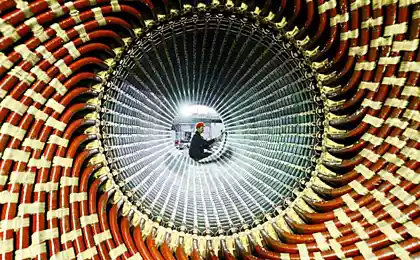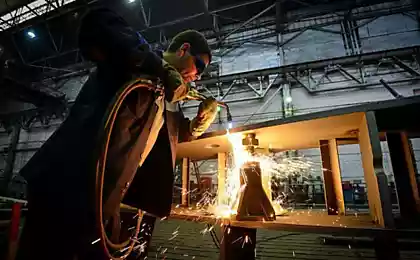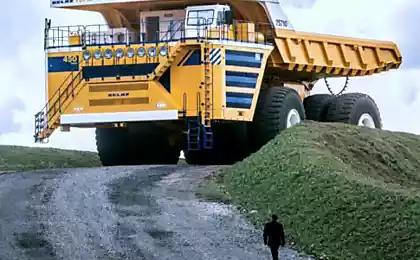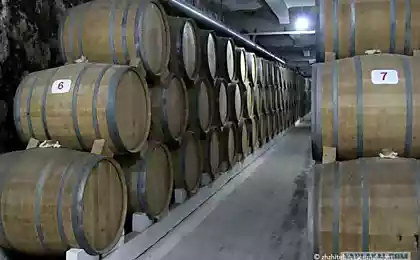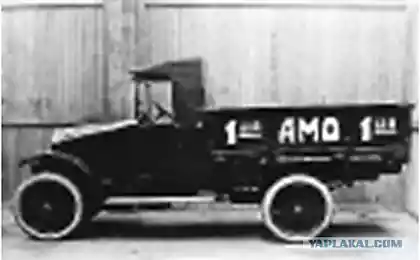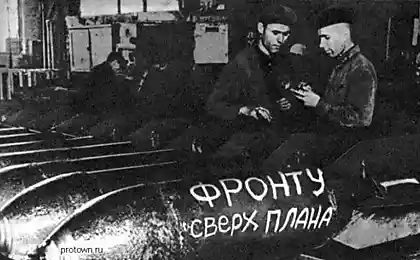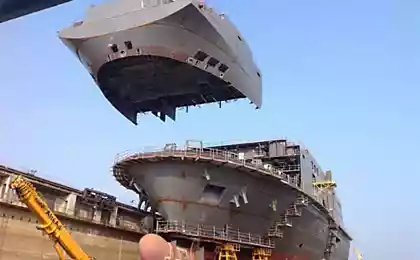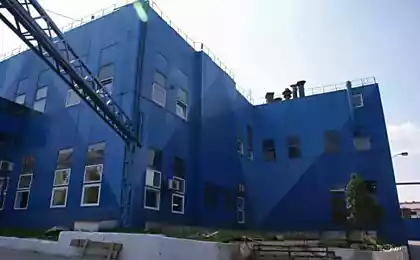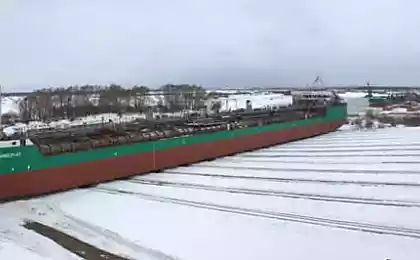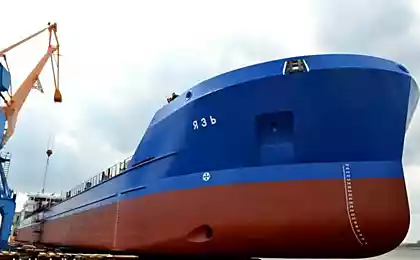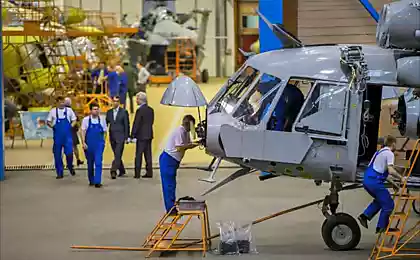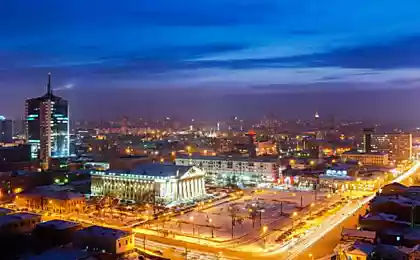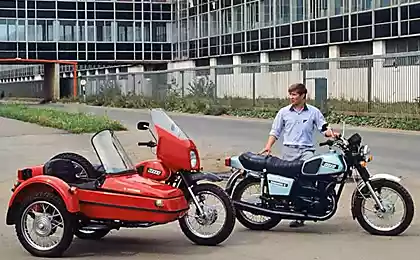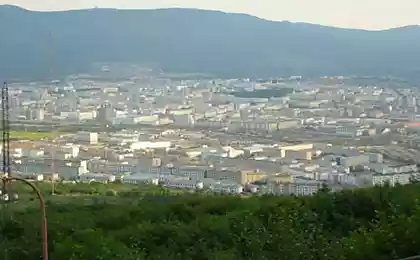3167
Chelyabinsk plant
CTZ - the legendary tractor factory in Chelyabinsk region. In addition to the production of tractors manufactured at the plant engineering vehicles for construction and public utilities, mining and energy sector, the forest industry and other economic sectors. Today we will learn how and what built the famous factory.
This is a very famous photograph greets you in the first hall of the museum CTZ. This is how to build a plant - bayonet spade, horse-carriage Grabarka, a huge manual labor. And at the same time in the "annals of the Chelyabinsk Tractor" we read: "Among the great buildings of the first Five-Year Plan Chelyabtraktorostroy was one of the most mechanized." Where is the truth? True, in this case exactly in the middle. Construction equipment on site CTZ was, but still is! - Bought for currency - although, of course, it was a little, and a lot of work is done manually. This is not to say that imported cars were "for the sake of showing off" - they used very intensively, because the task of the builders faced the daunting for her performance brought everything possible (and impossible) resources.
Start of construction in July 1930. Grabarka - horse carriage with a folding bottom. Top filled ground, Grabar was carrying on his blade, open bottom, soil spill. And so on, over and over again, day after day. Imagine how much was supposed to work. The first construction machinery arrived at the TTS until 1930. From the "Annals of the Chelyabinsk Tractor»:

Playground in the June days resembled a giant anthill. Everywhere - people with carts. Two months leveled land for laying shops, removed half a million cubic meters of earth. And all this was done in the absence of mechanisms by picks and shovels famous Grabar.
"Cars on the ground!" - This requirement is sounded from the pages of "Our tractor" [newspaper]. But the car was not there.
"700 konovozchikov transported to pull out of the steppe array sods. Diggers as large black ants swarming in the trenches. Earth taken from Kyle yes shovels ... To align the site takes a lot of human and horse sweat, but the daily rate of excavating the site of hilly places is not satisfied ... Since 21 of June production fell sharply. On this day konovozchiki without receiving from June 14, oats, not to go to work. The numbers from 22 th until the 25 th, daily rains made the job of leveling the site impossible "- wrote" Our tractor "1 July.
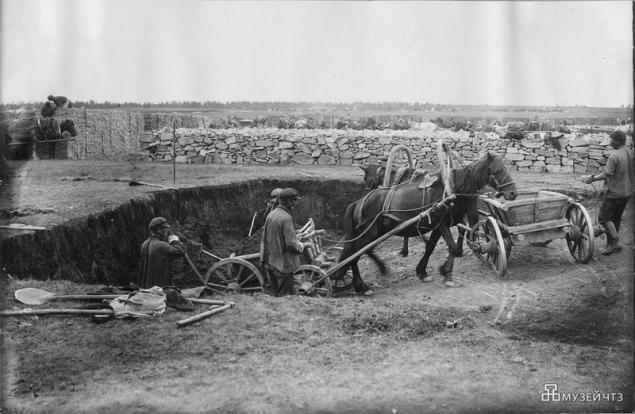
In addition grabarok at a construction site and used cars - this is a completely manual labor.
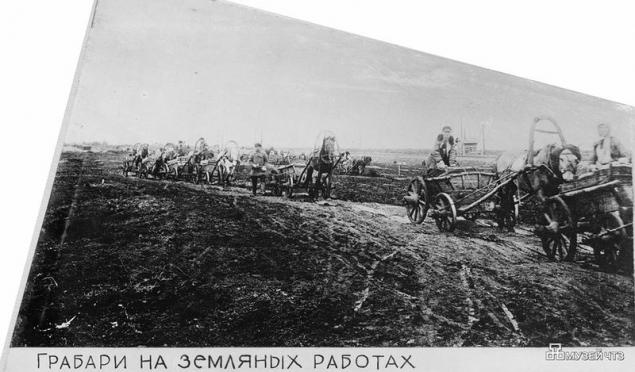
In general, the photographs of the period of manual labor very much - the builders are timber, attach the formwork, reinforcement knit, digging the ground, lay brick, and so on and so forth. Transport everywhere only cartage. Industrial site is covered with a dense network of narrow-gauge temporary branches - on them deliver building materials.
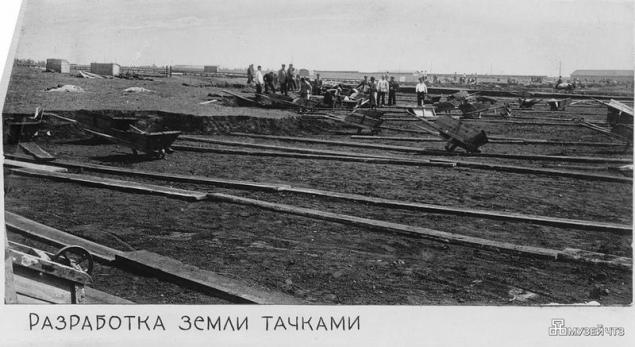
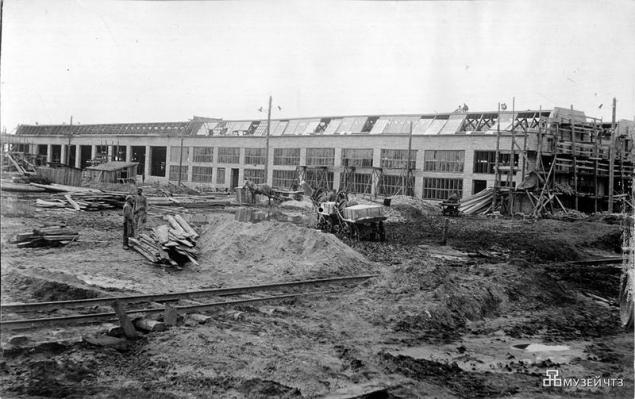
Almost the entire 1930 to Chelyabtraktorostroe worked without mechanisms under "Dubinushka." Only in the autumn of 1930, builders encountered crowds arrived purchased abroad excavator "Menk" two trencher American company "Austin," trailed grader company "Caterpillar" for the cars of the German company "Ornstein Koppel" rollers for compaction of road surfaces firm "Kemp" four lifting ticking company "Nord-West" and other equipment.
Earlier managed to get compressors and jackhammers to develop granite quarries and dozens of narrow-gauge trolleys. Trolley those already in the summer months render great service to the hauling of land with industrial site. The composition of trolleys loaded with the earth, "harnessed" tractor "Caterpillar" and he pulled them within a few kilometers to the dump.
All the equipment we look below, and this - tipping trucks, apparently, just discharged from the railway platforms.
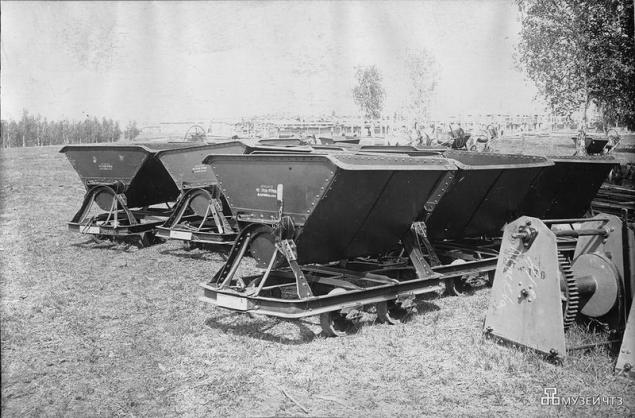
Marking is illegible, but the word "plant" can be read Cyrillic.
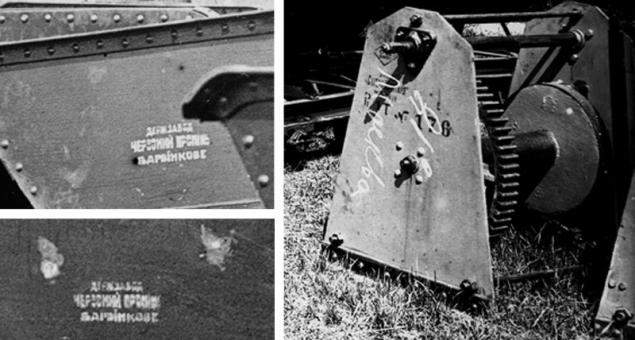
Trolley operation. This image is dated 3 July 1930.
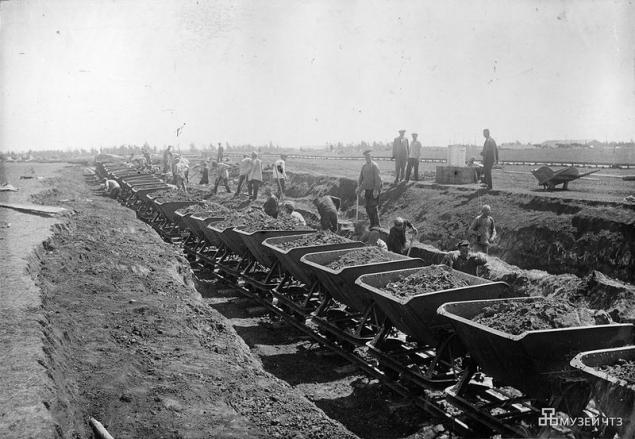
The only excavator on a construction site, 3 / viii-30.
That is, it turns out that in August 1930 at a construction site was already excavator, albeit on a railway platform.

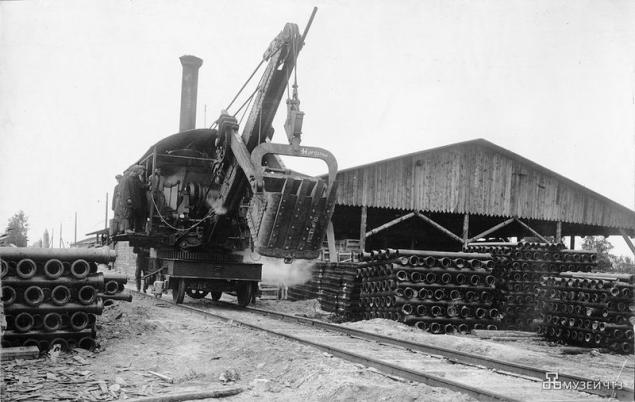
The big problem in the operation of imported equipment was banal inability to use it. You have to understand what kind of people worked on the construction tractor plant - in the recent past is just the peasants, who had never seen even the wheel of the tractor and in no small part to the Saw "mechanism" with skepticism and prejudice. However, and technology of those times was not so mature and reliable as the present.
With the arrival of large machinery methods and pace of work had to be changed. Given the acute shortage of workers in the construction needed to make best use of the mechanisms. Party committee, heads of the TTS were subject to a lot of attention. At a time when construction was not a single crane, a single excavator, looking forward, sent a group of eight people on Dneproges for development work on complex machines. In early 1931, the TTS were created courses that prepare Crane Motor excavator. These courses have sent the best workers - communists and Komsomol members. In March Chelyabtraktorostroe organized a special department of mechanization, which was to plan the work arrangements to care for them and repair, prepare staff. However, this training was conducted under-qualified, and most importantly - in a hurry.
Working people, seasonal workers, people who came from the land and plow, looked at the "strange" car with great interest, but still with some suspicion. For trencher crowd went builders, admired - "clever mechanism." But as soon as this "mechanism" to stop, and the faces of the audience instead of delight appeared cunning smile: "What is there any sense, and with a spatula but with a horse - it is true." So thought not only ordinary workers, but also some of the leaders. All of this came from the inability to handle the machine, due to lack of technical expertise.
However, in the summer of 1931 Best machine industrial site achieved high performance mechanisms. This was largely credited Boris Vasilevsky. In May, when half of the equipment was idle due to various failures, Vasilevsky via Komsomol organized repair mechanisms and has achieved increasing load some of them up to 80-90 percent.
Later, in early September, in the construction of steam power in the brigade Kapralova famous young Communist Bezrukavina. After okopchaniya courses minders she was sent to work as a laborer at zhilstroitelstvo saying that the girl with the machine still can not cope. Bezrukavina yet made to her put pa mixer "Kaiser". And after a few days she obeyed the mixer motor, which complained about all motorists. Bezrukavina worked and that night when kanralovtsy given record 509 batches. "Minder tractor is not ashamed to learn the care of a young machine operator mechanism-Communist comrade. Bezrukaviioy "- wrote" Chelyabinsk worker "in the room for September 6.
But experienced machine operators in the construction was still very small. Technique was used badly. But on her nasyschepnosti TTS significantly above the other building. Mechanisms were used by only 40 percent (81 of mechanism works only 33). The newspapers at that time published a summary of the mechanisms. Outages were huge: breakdowns, accidents, inability to organize the production process. "Do not force the machine to be truant!" - Demanded "Chelyabinsk Worker».
Communists - builders mechanoerecting wrote that "for the barbaric use of technology communists meet twice." Make good use of it interfere with personal responsibility, imperfect system of remuneration, poor knowledge of the mechanisms and low-skilled people who work for them. At a conference on mechanization, wrote Communists industrial site, you need to make a "clear analysis of each mechanism, each group of similar mechanisms (betonerki, cranes), summarize the experience, identify specific ways of mastering the mechanisms under our building. This should bring its experience all Communists - workers and specialists working on the arrangements. " [...]
- Work has been done a lot. Each mechanism, drawn from abroad, had a description, but know him only a narrow circle of people who directly took mechanisms - says YM Usherenko. - To become better acquainted with the technique of all those who served her, were created sections, which were drawn up a memo for each individual mechanism: how best to work out how to repair, how to quickly fix small problems. Reminders had to be clear and accessible to everyone. They prepared a team of specialists, the most well-versed in the art.
Party-technical conference but mechanization opened September 8, 1931 in a summer club CTZ and lasted the whole week. Report on the stroymohanizmov made deputy chief of construction VV Borisov. Then pas sections began to discuss Memo 16 theses on the most important and complex machines and mechanisms.
- After the conference - says YM Usherenko - began a campaign for the development of technology. Mass-circulation printed memo, developed at the conference. The newspaper began to appear a note about how much we need to take bread to get the equipment from abroad. Telling us how much it costs each mechanism, we encourage people to carefully otpositsya socialist property, to foster their attachment to the construction site, devotion to the common cause.
Conference produced tangible results. Mechanisms began to bring a much greater impact, the number of failures, malfunctions, downtime considerably reduced.
Excavator "Menk" stored on a variety of images - that he clamshell bucket here, that raises the wood or steel structures. Moreover, most likely on all pictures - one and the same instance.
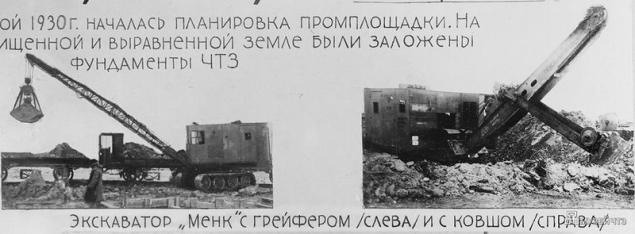


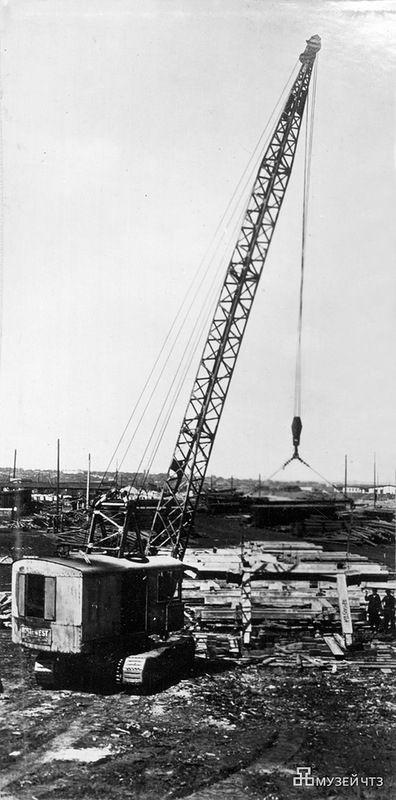

Trencher "Austin».
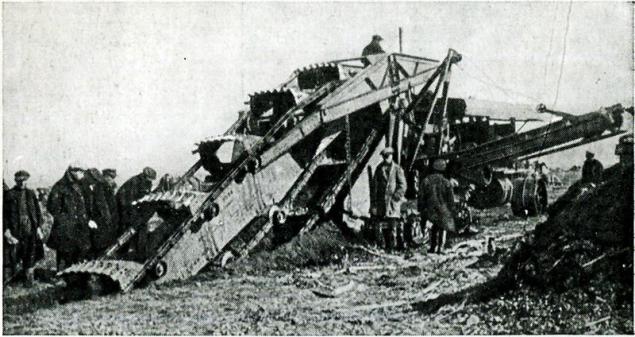

Tractor "Kommunar" Kharkiv production.
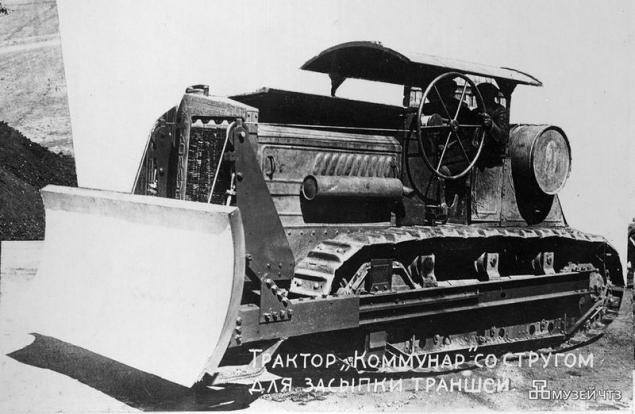

The arrival of the first concrete mixers, 29 / iv-30.
On the label (below) shows that it is "Kaiser»
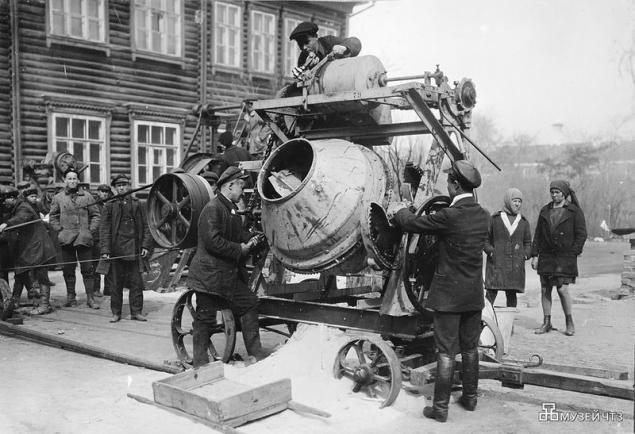
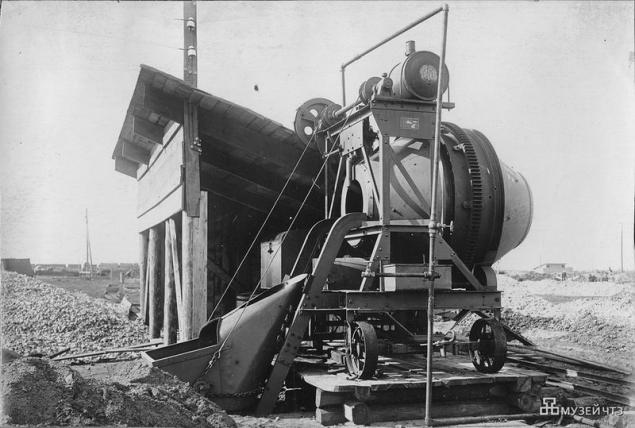
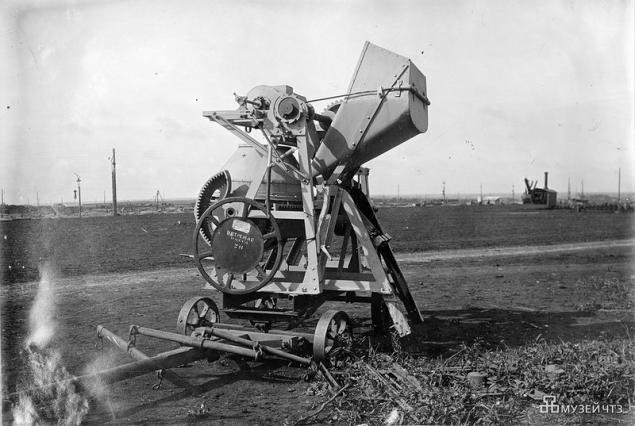
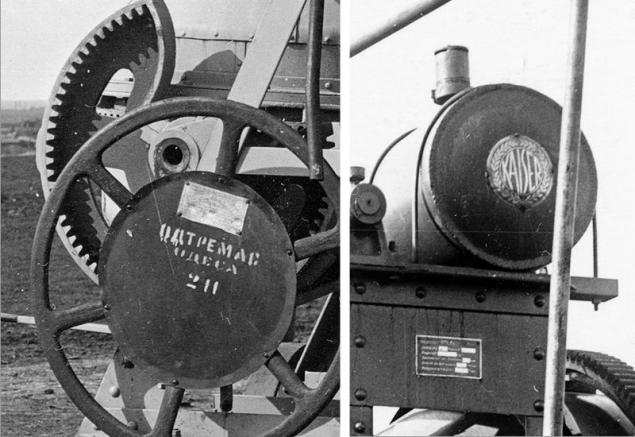
Transfer the mixer tap.
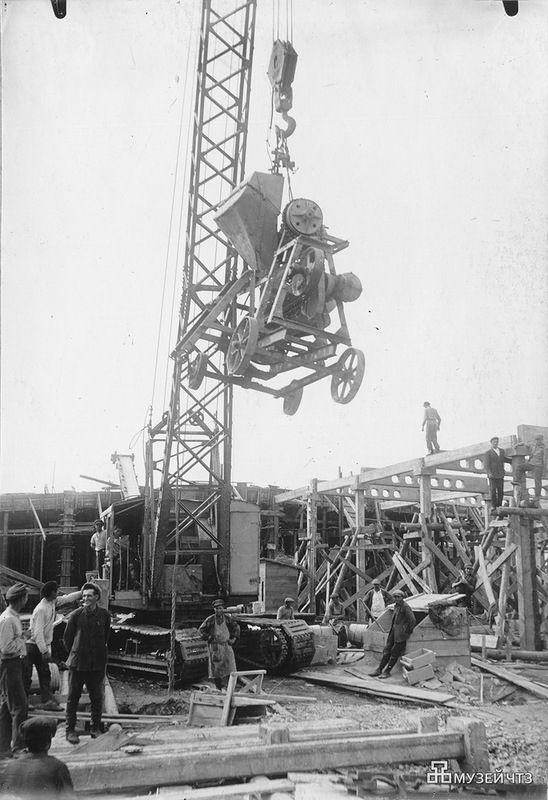
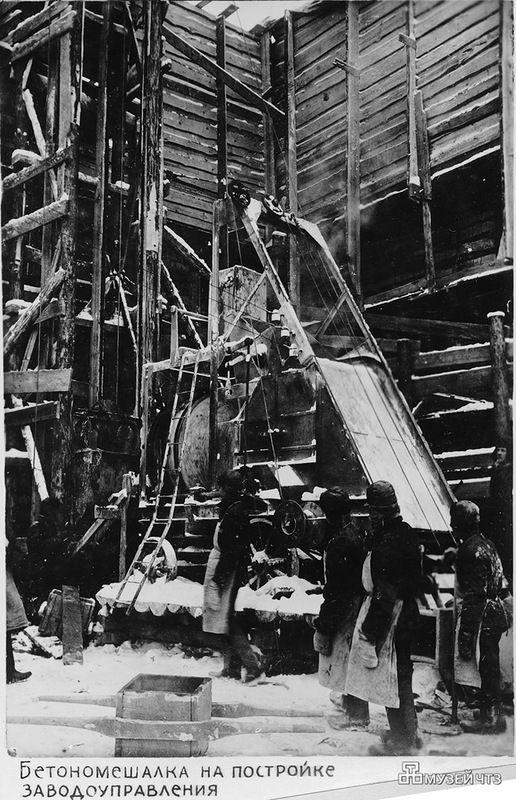
Later the mixer set on a mobile platform also.

Moreover, the platform is also imported. Look for inscriptions - one of the notes relates to 1920.
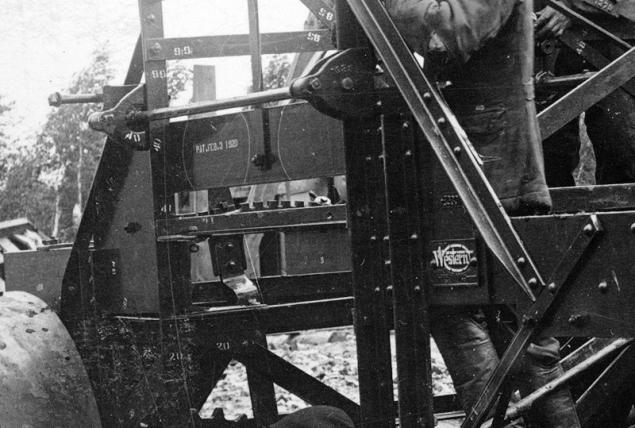
At the suggestion of the superintendent I. Ya Sapozhnikov and pomproraba Sipebryuhova narrow gauge railway in the shop paved in two lines, each placed on a platform with a concrete mixer, mine hoists and bunker. Concrete just four rows of columns in two bays. Material to bring up the rails in wheelbarrows, concrete mixer and stirred quite ready supplied in different directions. This greatly accelerated the construction of columns.
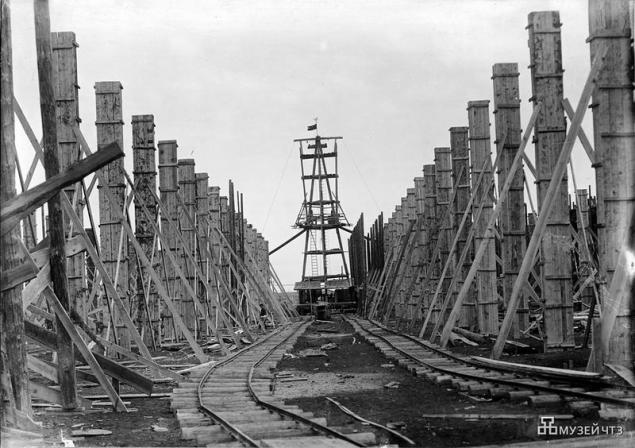
August 1930. Mortar station on the construction of a residential campus.
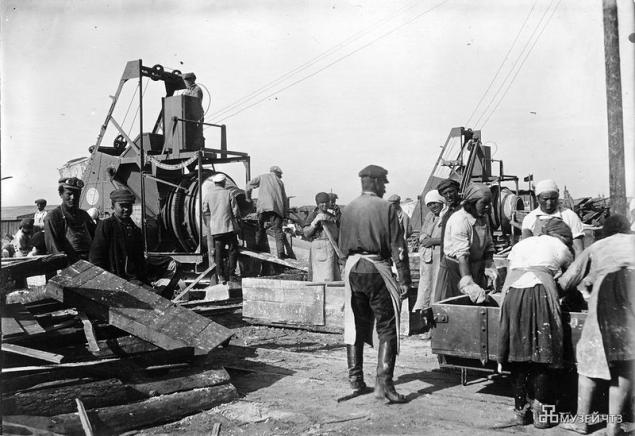

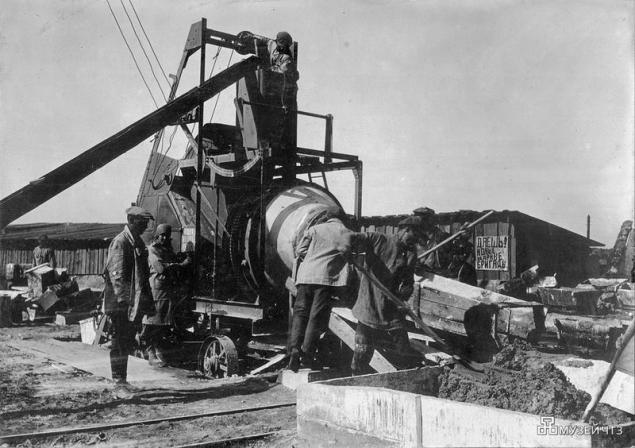
Finally, a "mortar factory».
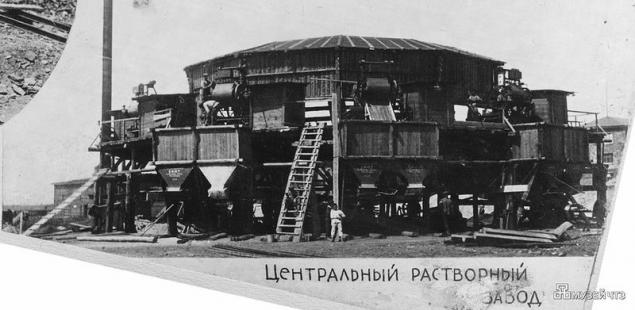
The main efforts were focused on the industrial site (factory shop), and if we talk about the construction of houses, here the situation was much more modest. Perhaps the top mechanization here - it's a belt conveyor for lifting bricks.
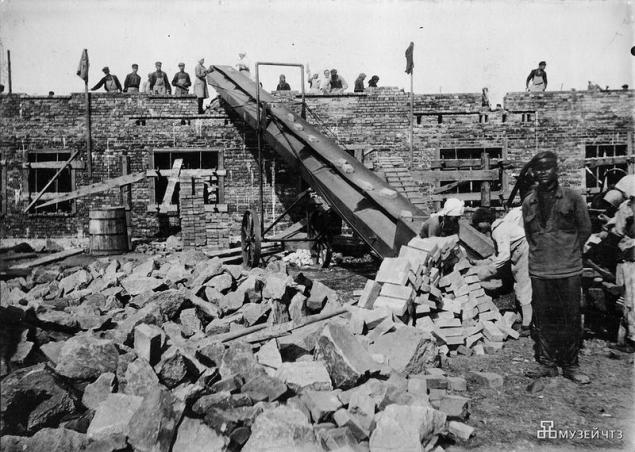
Basically, building material lifted onto the roof by ladder or a rope.
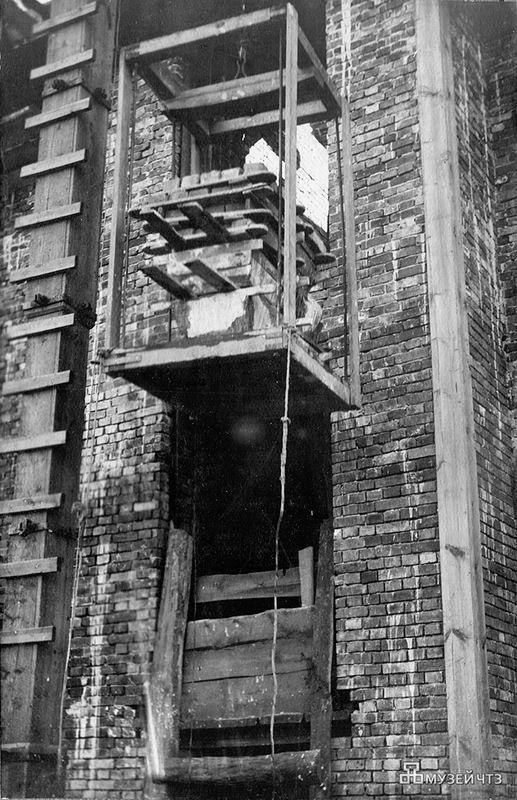

In the October 1930 shots on "Zhilstroy" appears crane "Kaiser". It seems that the only one in the building site.

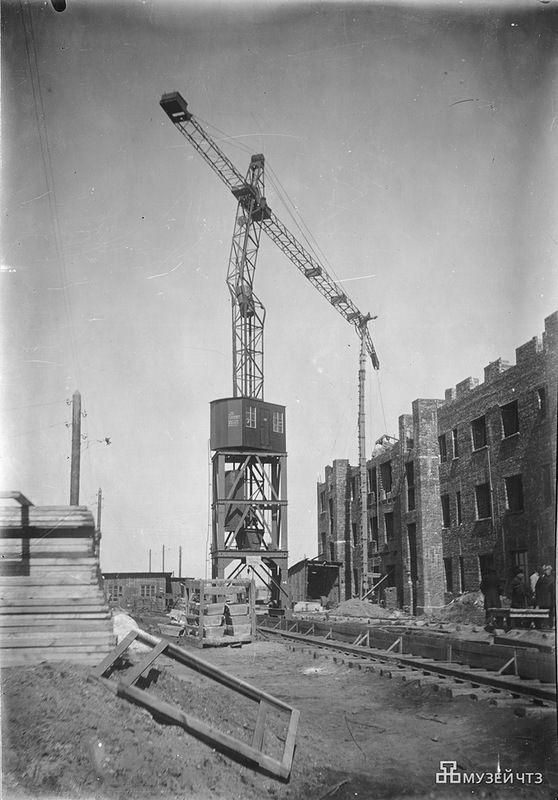
But later there was a nuisance to him.

Quarrying first time also conducted a sledgehammer, freight carried cartage.
In October and November 1929, began the development of granite quarries Shershni. Granite, as it turned out, it was required 360,000 cubic meters. If we consider the imperfect technique, which possessed the builders - a huge figure. It became clear that the antiquated methods of production of building stone not provide. In the spring of granite will need in large quantities.
- If there is no compressor, unless slides for lifting granite on board, if there is a railway line from the junction to careers, if not the barracks, there will be no granite, - said the head of the chief engineer of Gmina Lelkowo quarries Goldfinches. - Crowbar and sledgehammer granite will not give.
Soon the work started in the quarries. Of the road department sent a team of builders. A branch of the junction was built on frozen soils, and on it was taken lumber, brick. Began to build a dining room, office, barracks, storage of explosives. Later, the compressors, demolition team. By the spring of 1930 had already begun intensive extraction of granite; its trains were sent to the building. Later Traktorostroyu passed and Sosnovsky career. Here organized production of crushed stone, built kamiekolny plant.
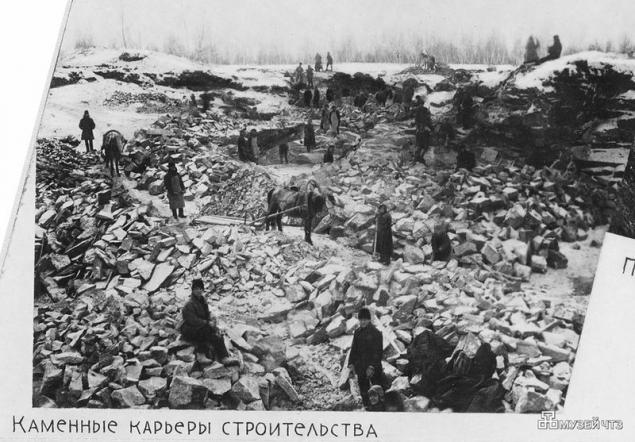
But over time, there are many mechanisms - compressors, crushers, winches.
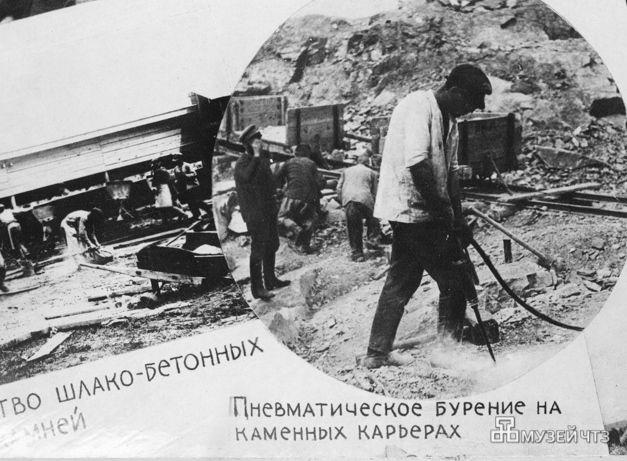
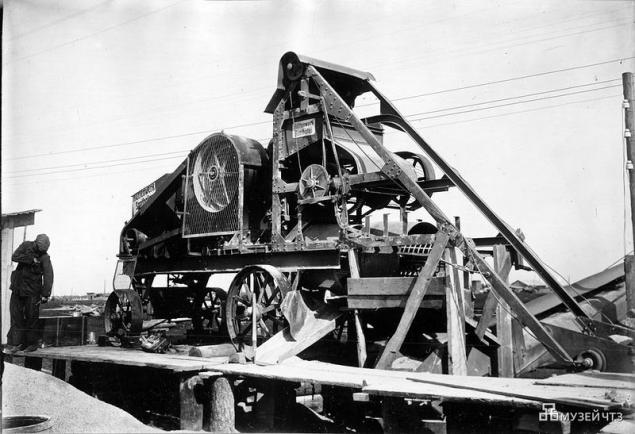
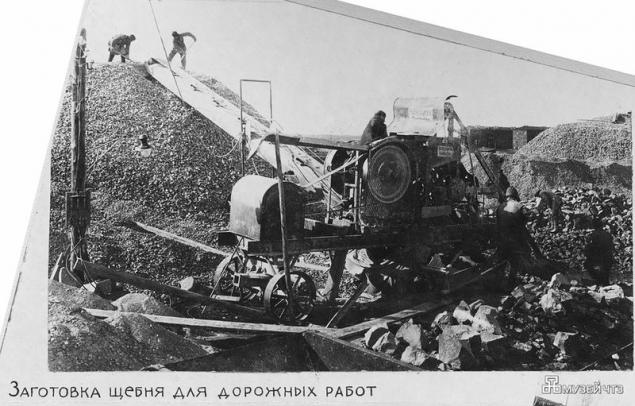
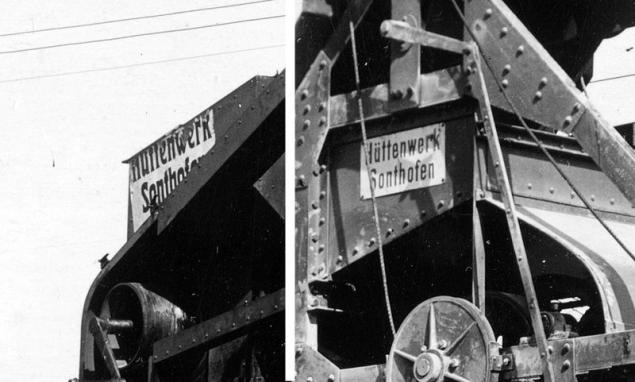
The power plant.
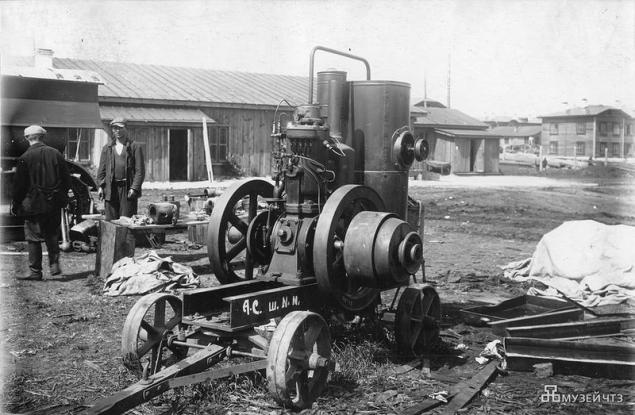

The city's first asphalt roller. This photo is dated May 30, 1930.
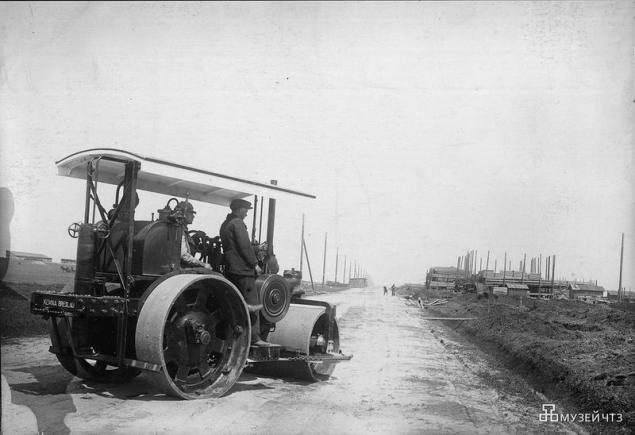
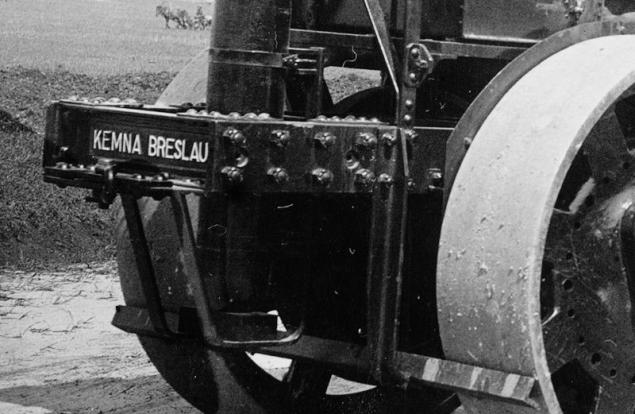
Fire Station. And a fire truck on the basis of the AMO.

After completing the main phase of construction (1932), CTZ began to buy equipment for the production itself.
Construction entered during the installation of the equipment. Party machines for the first stage of the shops have started to arrive on site. Most of the equipment was ordered abroad.
- In Germany, the Commission ordered CTZ equipment and tooling over forty companies - says Alexander Glazunov. - The economic crisis that hit the capitalist world, has created favorable conditions for placing orders. To survive and not go bankrupt in a depression (in German the word "crisis" is not pronounced, but only - "depression"), manufacturers are no longer thought of income, and about how to make ends meet. Using competition between firms when placing orders we received great savings currency. These savings, for example, was able to order a batch of abrasive products, providing more than the annual requirement CTZ.
Our purchases have caused great excitement among the industrialists. Commission Chelyabtraktorostroya became widely known not only in Germany but also in Czechoslovakia, in Switzerland. The last we ordered the exact machines "Sip" devices and casting machines. Much of the equipment for the Chelyabinsk Tractor Plant ordered in Soviet enterprises. Soviet industry was beginning to get on his feet. In addition, it was necessary to save the currency.
What was the equipment, we can now also be seen on the photos, thanks to the museum CTZ.
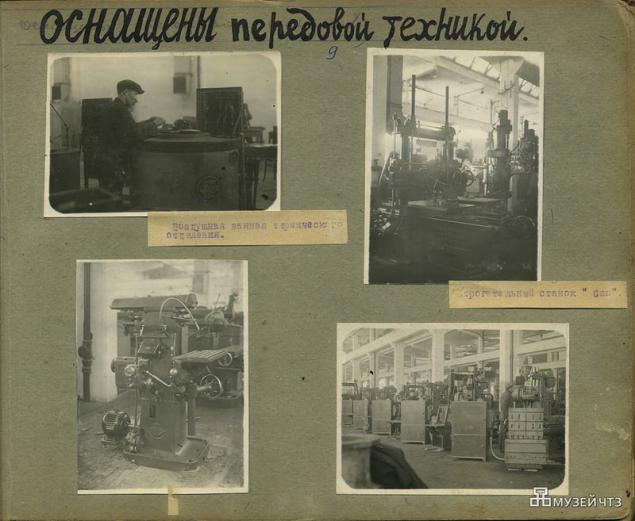

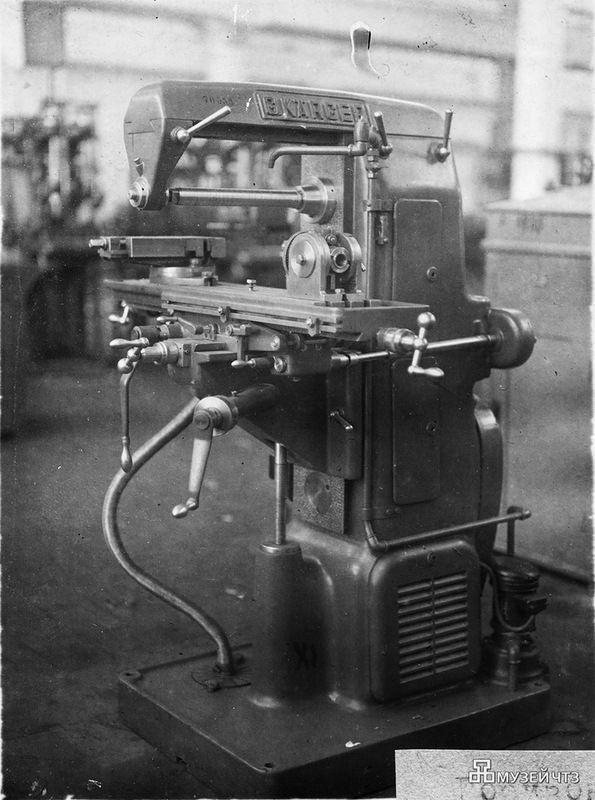
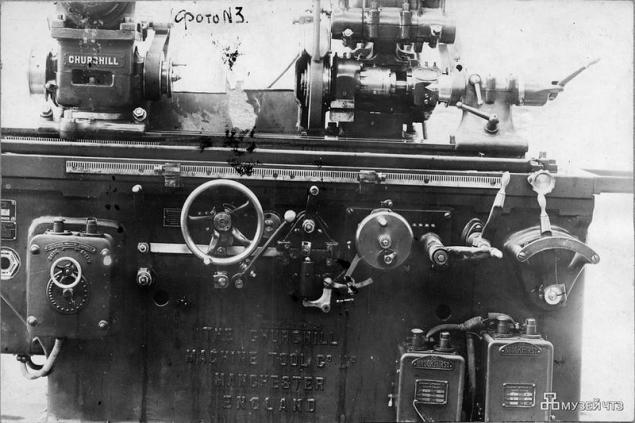
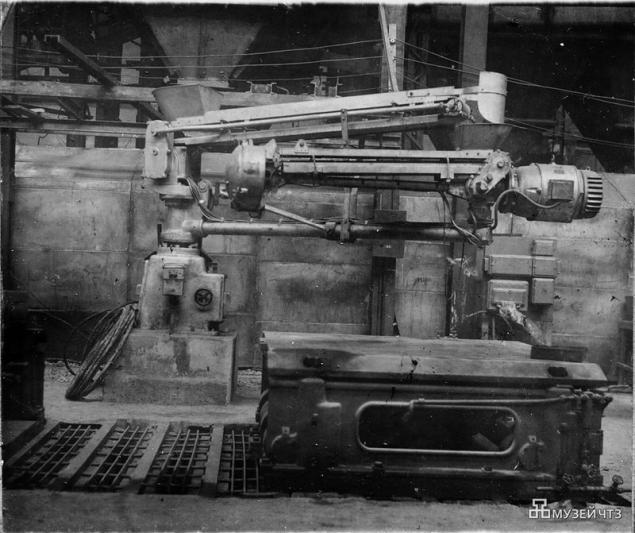

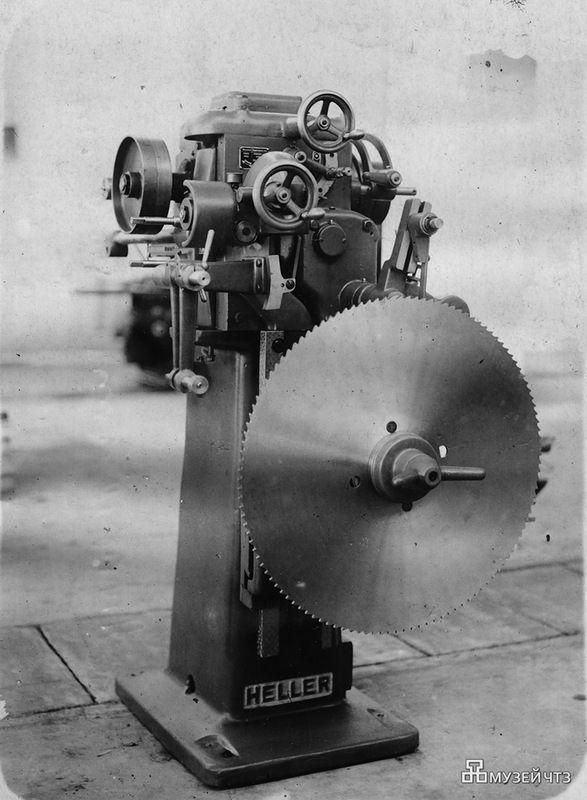
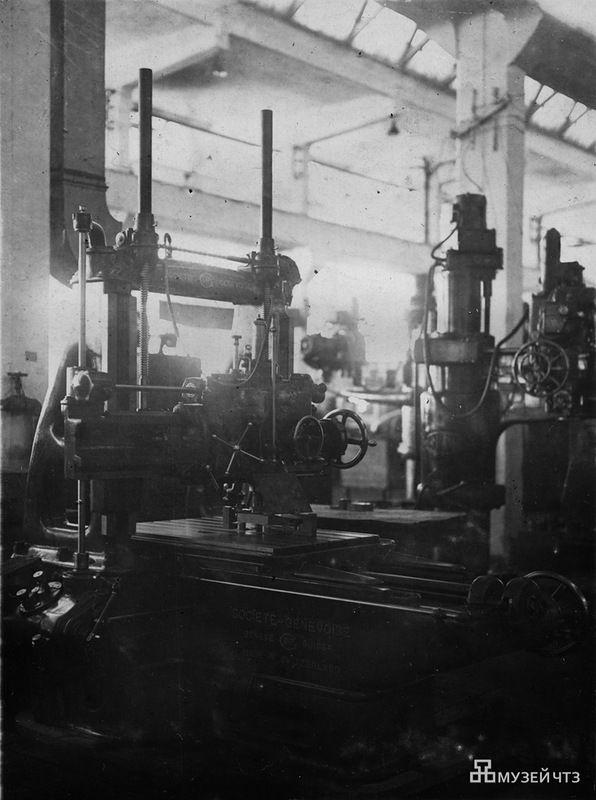
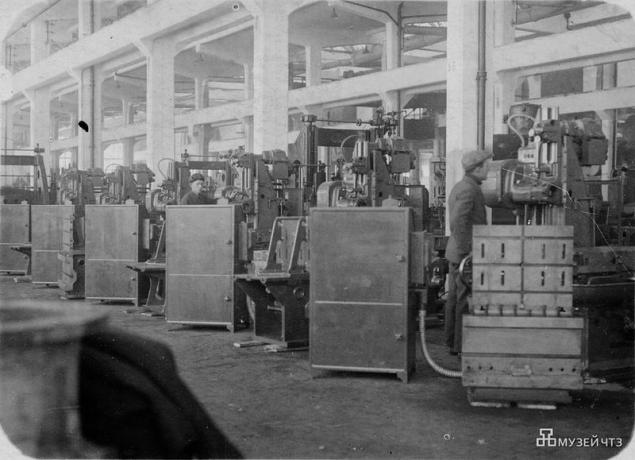
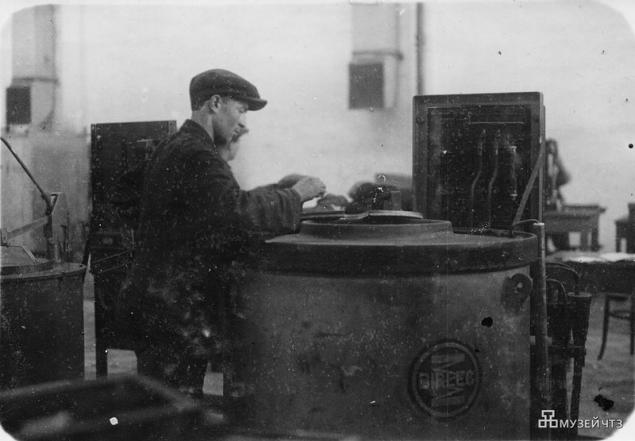

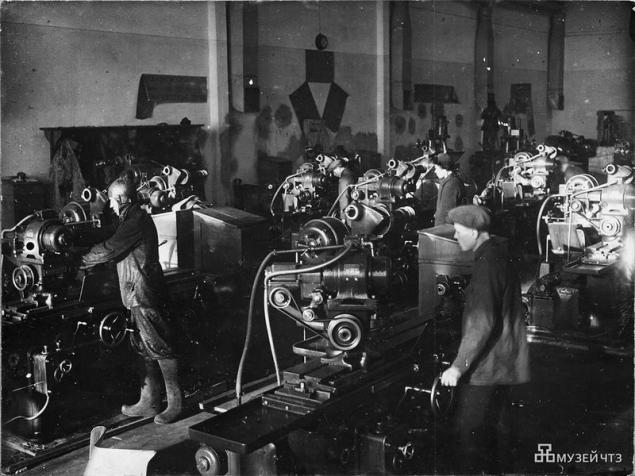
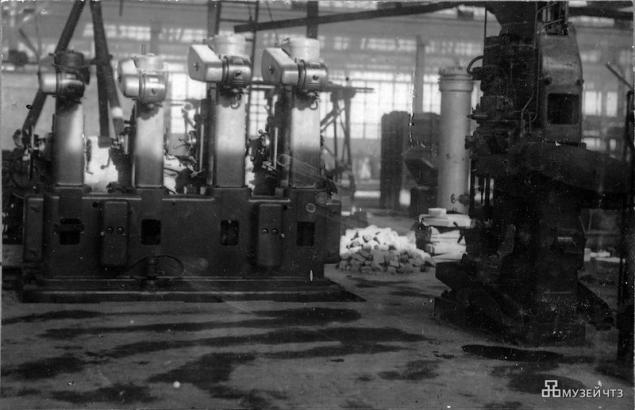
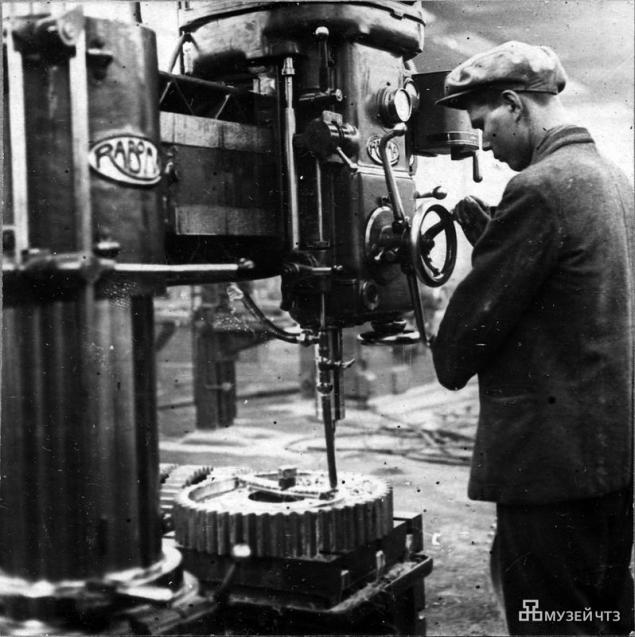

Accordingly, to master all this technology is also needed to learn.
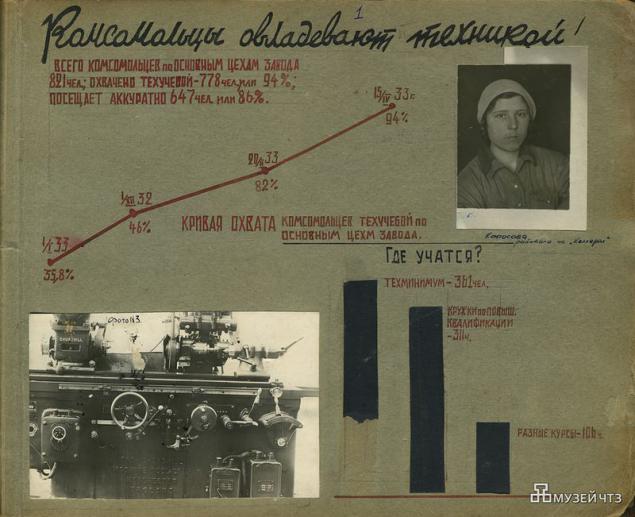
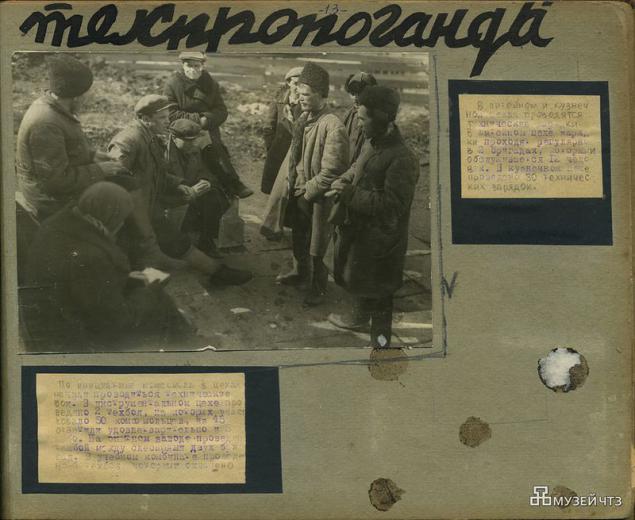
Source: ssgen.livejournal.com
This is a very famous photograph greets you in the first hall of the museum CTZ. This is how to build a plant - bayonet spade, horse-carriage Grabarka, a huge manual labor. And at the same time in the "annals of the Chelyabinsk Tractor" we read: "Among the great buildings of the first Five-Year Plan Chelyabtraktorostroy was one of the most mechanized." Where is the truth? True, in this case exactly in the middle. Construction equipment on site CTZ was, but still is! - Bought for currency - although, of course, it was a little, and a lot of work is done manually. This is not to say that imported cars were "for the sake of showing off" - they used very intensively, because the task of the builders faced the daunting for her performance brought everything possible (and impossible) resources.
Start of construction in July 1930. Grabarka - horse carriage with a folding bottom. Top filled ground, Grabar was carrying on his blade, open bottom, soil spill. And so on, over and over again, day after day. Imagine how much was supposed to work. The first construction machinery arrived at the TTS until 1930. From the "Annals of the Chelyabinsk Tractor»:

Playground in the June days resembled a giant anthill. Everywhere - people with carts. Two months leveled land for laying shops, removed half a million cubic meters of earth. And all this was done in the absence of mechanisms by picks and shovels famous Grabar.
"Cars on the ground!" - This requirement is sounded from the pages of "Our tractor" [newspaper]. But the car was not there.
"700 konovozchikov transported to pull out of the steppe array sods. Diggers as large black ants swarming in the trenches. Earth taken from Kyle yes shovels ... To align the site takes a lot of human and horse sweat, but the daily rate of excavating the site of hilly places is not satisfied ... Since 21 of June production fell sharply. On this day konovozchiki without receiving from June 14, oats, not to go to work. The numbers from 22 th until the 25 th, daily rains made the job of leveling the site impossible "- wrote" Our tractor "1 July.

In addition grabarok at a construction site and used cars - this is a completely manual labor.

In general, the photographs of the period of manual labor very much - the builders are timber, attach the formwork, reinforcement knit, digging the ground, lay brick, and so on and so forth. Transport everywhere only cartage. Industrial site is covered with a dense network of narrow-gauge temporary branches - on them deliver building materials.


Almost the entire 1930 to Chelyabtraktorostroe worked without mechanisms under "Dubinushka." Only in the autumn of 1930, builders encountered crowds arrived purchased abroad excavator "Menk" two trencher American company "Austin," trailed grader company "Caterpillar" for the cars of the German company "Ornstein Koppel" rollers for compaction of road surfaces firm "Kemp" four lifting ticking company "Nord-West" and other equipment.
Earlier managed to get compressors and jackhammers to develop granite quarries and dozens of narrow-gauge trolleys. Trolley those already in the summer months render great service to the hauling of land with industrial site. The composition of trolleys loaded with the earth, "harnessed" tractor "Caterpillar" and he pulled them within a few kilometers to the dump.
All the equipment we look below, and this - tipping trucks, apparently, just discharged from the railway platforms.

Marking is illegible, but the word "plant" can be read Cyrillic.

Trolley operation. This image is dated 3 July 1930.

The only excavator on a construction site, 3 / viii-30.
That is, it turns out that in August 1930 at a construction site was already excavator, albeit on a railway platform.


The big problem in the operation of imported equipment was banal inability to use it. You have to understand what kind of people worked on the construction tractor plant - in the recent past is just the peasants, who had never seen even the wheel of the tractor and in no small part to the Saw "mechanism" with skepticism and prejudice. However, and technology of those times was not so mature and reliable as the present.
With the arrival of large machinery methods and pace of work had to be changed. Given the acute shortage of workers in the construction needed to make best use of the mechanisms. Party committee, heads of the TTS were subject to a lot of attention. At a time when construction was not a single crane, a single excavator, looking forward, sent a group of eight people on Dneproges for development work on complex machines. In early 1931, the TTS were created courses that prepare Crane Motor excavator. These courses have sent the best workers - communists and Komsomol members. In March Chelyabtraktorostroe organized a special department of mechanization, which was to plan the work arrangements to care for them and repair, prepare staff. However, this training was conducted under-qualified, and most importantly - in a hurry.
Working people, seasonal workers, people who came from the land and plow, looked at the "strange" car with great interest, but still with some suspicion. For trencher crowd went builders, admired - "clever mechanism." But as soon as this "mechanism" to stop, and the faces of the audience instead of delight appeared cunning smile: "What is there any sense, and with a spatula but with a horse - it is true." So thought not only ordinary workers, but also some of the leaders. All of this came from the inability to handle the machine, due to lack of technical expertise.
However, in the summer of 1931 Best machine industrial site achieved high performance mechanisms. This was largely credited Boris Vasilevsky. In May, when half of the equipment was idle due to various failures, Vasilevsky via Komsomol organized repair mechanisms and has achieved increasing load some of them up to 80-90 percent.
Later, in early September, in the construction of steam power in the brigade Kapralova famous young Communist Bezrukavina. After okopchaniya courses minders she was sent to work as a laborer at zhilstroitelstvo saying that the girl with the machine still can not cope. Bezrukavina yet made to her put pa mixer "Kaiser". And after a few days she obeyed the mixer motor, which complained about all motorists. Bezrukavina worked and that night when kanralovtsy given record 509 batches. "Minder tractor is not ashamed to learn the care of a young machine operator mechanism-Communist comrade. Bezrukaviioy "- wrote" Chelyabinsk worker "in the room for September 6.
But experienced machine operators in the construction was still very small. Technique was used badly. But on her nasyschepnosti TTS significantly above the other building. Mechanisms were used by only 40 percent (81 of mechanism works only 33). The newspapers at that time published a summary of the mechanisms. Outages were huge: breakdowns, accidents, inability to organize the production process. "Do not force the machine to be truant!" - Demanded "Chelyabinsk Worker».
Communists - builders mechanoerecting wrote that "for the barbaric use of technology communists meet twice." Make good use of it interfere with personal responsibility, imperfect system of remuneration, poor knowledge of the mechanisms and low-skilled people who work for them. At a conference on mechanization, wrote Communists industrial site, you need to make a "clear analysis of each mechanism, each group of similar mechanisms (betonerki, cranes), summarize the experience, identify specific ways of mastering the mechanisms under our building. This should bring its experience all Communists - workers and specialists working on the arrangements. " [...]
- Work has been done a lot. Each mechanism, drawn from abroad, had a description, but know him only a narrow circle of people who directly took mechanisms - says YM Usherenko. - To become better acquainted with the technique of all those who served her, were created sections, which were drawn up a memo for each individual mechanism: how best to work out how to repair, how to quickly fix small problems. Reminders had to be clear and accessible to everyone. They prepared a team of specialists, the most well-versed in the art.
Party-technical conference but mechanization opened September 8, 1931 in a summer club CTZ and lasted the whole week. Report on the stroymohanizmov made deputy chief of construction VV Borisov. Then pas sections began to discuss Memo 16 theses on the most important and complex machines and mechanisms.
- After the conference - says YM Usherenko - began a campaign for the development of technology. Mass-circulation printed memo, developed at the conference. The newspaper began to appear a note about how much we need to take bread to get the equipment from abroad. Telling us how much it costs each mechanism, we encourage people to carefully otpositsya socialist property, to foster their attachment to the construction site, devotion to the common cause.
Conference produced tangible results. Mechanisms began to bring a much greater impact, the number of failures, malfunctions, downtime considerably reduced.
Excavator "Menk" stored on a variety of images - that he clamshell bucket here, that raises the wood or steel structures. Moreover, most likely on all pictures - one and the same instance.





Trencher "Austin».


Tractor "Kommunar" Kharkiv production.


The arrival of the first concrete mixers, 29 / iv-30.
On the label (below) shows that it is "Kaiser»




Transfer the mixer tap.


Later the mixer set on a mobile platform also.

Moreover, the platform is also imported. Look for inscriptions - one of the notes relates to 1920.

At the suggestion of the superintendent I. Ya Sapozhnikov and pomproraba Sipebryuhova narrow gauge railway in the shop paved in two lines, each placed on a platform with a concrete mixer, mine hoists and bunker. Concrete just four rows of columns in two bays. Material to bring up the rails in wheelbarrows, concrete mixer and stirred quite ready supplied in different directions. This greatly accelerated the construction of columns.

August 1930. Mortar station on the construction of a residential campus.



Finally, a "mortar factory».

The main efforts were focused on the industrial site (factory shop), and if we talk about the construction of houses, here the situation was much more modest. Perhaps the top mechanization here - it's a belt conveyor for lifting bricks.

Basically, building material lifted onto the roof by ladder or a rope.


In the October 1930 shots on "Zhilstroy" appears crane "Kaiser". It seems that the only one in the building site.


But later there was a nuisance to him.

Quarrying first time also conducted a sledgehammer, freight carried cartage.
In October and November 1929, began the development of granite quarries Shershni. Granite, as it turned out, it was required 360,000 cubic meters. If we consider the imperfect technique, which possessed the builders - a huge figure. It became clear that the antiquated methods of production of building stone not provide. In the spring of granite will need in large quantities.
- If there is no compressor, unless slides for lifting granite on board, if there is a railway line from the junction to careers, if not the barracks, there will be no granite, - said the head of the chief engineer of Gmina Lelkowo quarries Goldfinches. - Crowbar and sledgehammer granite will not give.
Soon the work started in the quarries. Of the road department sent a team of builders. A branch of the junction was built on frozen soils, and on it was taken lumber, brick. Began to build a dining room, office, barracks, storage of explosives. Later, the compressors, demolition team. By the spring of 1930 had already begun intensive extraction of granite; its trains were sent to the building. Later Traktorostroyu passed and Sosnovsky career. Here organized production of crushed stone, built kamiekolny plant.

But over time, there are many mechanisms - compressors, crushers, winches.




The power plant.


The city's first asphalt roller. This photo is dated May 30, 1930.


Fire Station. And a fire truck on the basis of the AMO.

After completing the main phase of construction (1932), CTZ began to buy equipment for the production itself.
Construction entered during the installation of the equipment. Party machines for the first stage of the shops have started to arrive on site. Most of the equipment was ordered abroad.
- In Germany, the Commission ordered CTZ equipment and tooling over forty companies - says Alexander Glazunov. - The economic crisis that hit the capitalist world, has created favorable conditions for placing orders. To survive and not go bankrupt in a depression (in German the word "crisis" is not pronounced, but only - "depression"), manufacturers are no longer thought of income, and about how to make ends meet. Using competition between firms when placing orders we received great savings currency. These savings, for example, was able to order a batch of abrasive products, providing more than the annual requirement CTZ.
Our purchases have caused great excitement among the industrialists. Commission Chelyabtraktorostroya became widely known not only in Germany but also in Czechoslovakia, in Switzerland. The last we ordered the exact machines "Sip" devices and casting machines. Much of the equipment for the Chelyabinsk Tractor Plant ordered in Soviet enterprises. Soviet industry was beginning to get on his feet. In addition, it was necessary to save the currency.
What was the equipment, we can now also be seen on the photos, thanks to the museum CTZ.















Accordingly, to master all this technology is also needed to learn.


Source: ssgen.livejournal.com
